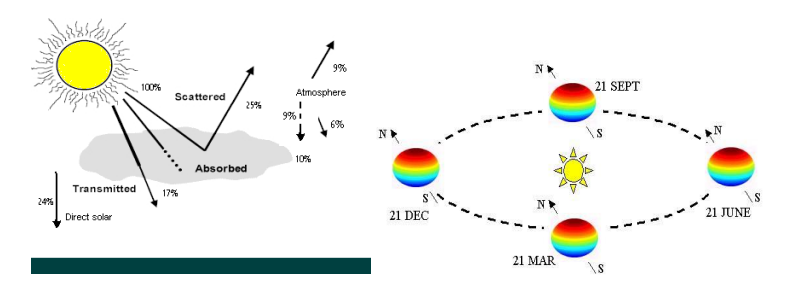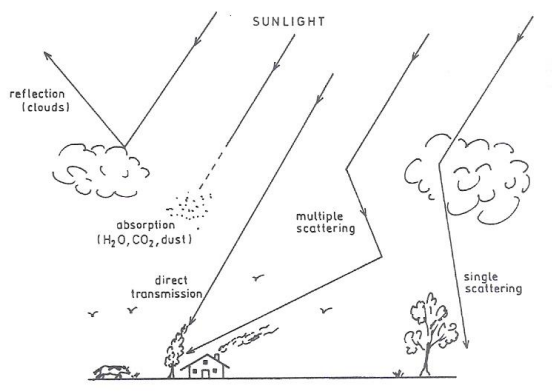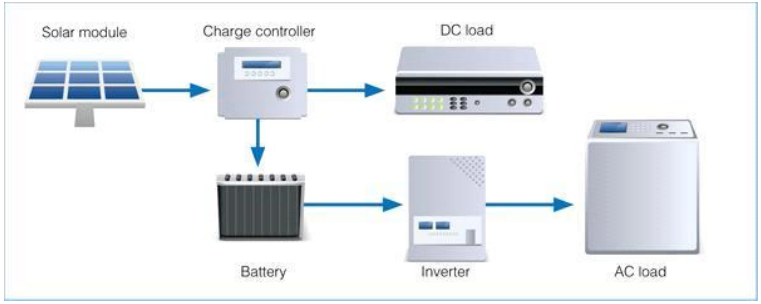Solar Energy
The sun’s light can be used as an alternative source of energy of electricity. The main concentration in this project is the generation of power from solar PV. The design of PV system depends on solar radiation. The sun is the source of solar energy. It acts as an emitter for solar radiation with average of 1000W/m2 at 25oC at standard test condition. The earth’s surface receives about 47% of the total solar energy that reaches the earth. Only this amount is usable for usage purposes.

The earth revolves orbit the sun in an elliptical orbit. The earth’s axis of rotation is tilted at 23.5o with respect to its elliptical axis about the sun. Due to the earth’s rotation and yearly revolution around the sun, the energy that reaches the surface varies on hourly and seasonal basis depending on the location.
Solar radiation also called as solar insolation is the product of the sun with any location of the earth. Solar energy production is highly dependent on the quality of solar insolation. Solar insolation can be received thru 2 different type of radiation. There are direct radiation and diffuse radiation. Direct radiation refers to the solar radiation which gives direct transmission to the earth. It is also known as beam radiation. While, for diffuse radiation solar radiation diffuses with the particle in the air (air, dust and water). Diffuses radiation can lower the quality of solar radiation.
Because of this, solar radiation has no constant radiation and can vary greatly. Other than that, the solar insolation also varies with the time of the day. Solar insolation hits peak radiation during the midday and there are no solar radiation in the night.

The average intensity of solar insolation reaching the earth’s atmosphere is around 1353 W/m.2. The solar insolation which passes through the atmosphere are called global solar insolation, IGLOBAL. IGLOBAL is then divided into beam solar radiation, IDIRECT, reflected radiation IREFLECT, and diffuse solar radiation, IDIFFUSE. Their relationship can be express as the following equation.
IG = I B+ ID + IR (1)
Solar insolation can be affected thru shading effect. Shading effect is caused by clouds, dusts and pollutants. This effect cannot be avoided and all these combined with the transient nature of global irradiance can greatly affect the quality of solar insolation.
Angles made by solar radiation on receiving surface
In order to get a good sun tracking SEGS, there are calculations needed to be made. The main angle we need to focus on is the tilt angle, but in order to get tilt angle we need to find other angles associated with the tilt angle. These angles are needed to determine the right tilt and orientation of the PV system. Sun’s apparent position is calculated based on elevation and azimuth angles, A. the azimuth angle can be calculated using the equation 2.
A=cos-1[sinδcosф-cosδsinϕcos(HRA)/cosα] (2)
Elevation, α=sin-1[sinδsin+cosδcosϕcos(HRA)] (3)
The position’s latitude, ϕ is obtained from Global Positioning System (GPS). Angle of declination,δ is the angular displacement of the sun to the center of the earth and is calculated using equation 4 and the Hour Angle (HRA) is calculated using equation 5.The d represents day in a year.
δ=23.45°sin[360(d+284)/365] (4)
HRA=15°(LST-12) (5)
The local solar time (LST) can be calculated using equation 6. The Time Correction (TC) factor (in minues) is the variation of the LST within a given time zone due to the longitude variations and local time (LT). The TC is calculated using equation 7.
LST+LT+TC/60 (6)
TC=4(Longitude-LSTM)+EoT (7)
The Local Standard Meridian (LSTM) is a reference meridian used for a particular time zone and it is calculated using equation 8. The ΔTGMT is the difference of the local time (LT) from Greenwich Mean Tim (GMT) in hours and the equation of time (EoT) is calculated by equation 9 with B (in degree) is calculated in equation 10.
LSTM=15°.ΔTGMT (8)
EoT=sin(2B)-7.53cos(B)-1.5sin(B) (9)
B=360/365*(d-81) (10)
Based from this equation 2 and 3, we can see that the information on the time of the day and also the location data as an input. This shows that different time or location produces different elevation and azimuth angles.
Solar Energy Generation System
Solar power system mainly uses PV modules to convert sunlight to electricity. The electricity produced can be stored in battery or used directly depending on their uses. Solar generator consists of components. These components are selected according to the system type, location and applications. The components for solar generation systems are:
- PV module
- Solar Charger Controller
- Power inverter
- Battery
- Load

Solar generation system can also be divided according to their application. Which are stand-alone applications and grid-connected applications. Stand-alone solar generation systems are separated from the power grid. It only uses solar panels to power-up the applications. Stand-alone solar generation system can also be divided into smaller categories; direct-coupled system and stand-alone system with batteries. The main different between direct-coupled system and stand-alone system with batteries are the presence of battery. The direct-coupled system provides power directly to the application from solar generator with solar panel while the stand-alone system with batteries provides power thru the batteries. The direct-coupled system can only be used during the day while the stand-alone system with batteries can be used at any time due to the energy stored in the battery. The functions of storage battery in stand-alone system with batteries are:
- Energy storage capacity and autonomy – to store energy when there is an excess is available and provide it when needed
- Voltage and current stabilization – to provide stable current and voltage
- Supply surge current – to provide surge currents to loads

The main concern for stand-alone systems is load related problems. Unlike gridconnected system the stand-alone needed to provide power with accordance to the load of the applications. The stand-alone system does not have the backing of grid system for excess load.
